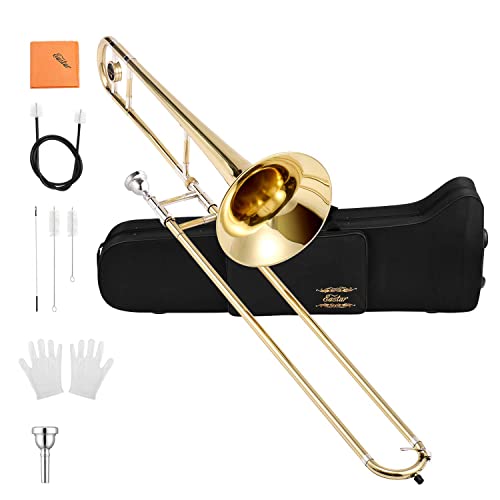Hello, trombone enthusiasts! So, you’ve mastered the slide positions and can hit those low notes like a pro. But have you ever stopped mid-jam session and thought, “How much does this thing actually weigh?” Or maybe you’re prepping for a gig and wondering if lugging your trombone and its case around is going to be a full-body workout.
Well, you’re in the perfect spot to find out. We’ll break down the mysteries of trombone weight—piece by piece. We’ll start off by revealing just how much that shiny trombone of yours weighs. Spoiler: it’s probably lighter than you think.
We’ll also dive into the weight of trombone cases because, let’s face it, that’s part of the package. And to top it all off, we’ll delve into the dimensions of a trombone, so you’ll know whether it’ll fit in your car, your closet, or wherever you might be lugging it.
Ready to become a trombone-weight guru? Let’s slide right in!
Table of Contents
How Much Does a Trombone Weigh?
Now, if you think all trombones weigh the same, you’re in for a surprise. It’s a whole variety pack of sorts out there, and we’re here to give you the lowdown.
First up, what’s the average weight of a trombone? The range is typically between 3 and 8 pounds. It’s a bit of a spread, and it all comes down to factors like materials and the brand.
Let’s break it down further. You’ve got your small, medium, and large bore trombones, each with their own flair. Add-ons like F-attachments—either open or closed wrap—can alter that weight, too. Fun fact: a large-bore pro-level tenor trombone with a full wrap F-attachment weighs in at around 4 pounds.
Moving on to the student models, those petite small-bore trombones you see in school bands usually weigh a bit less than their large-bore counterparts. It’s all about the material! Different metal alloys come with different weights, naturally.
We can’t forget about the brand factor either. Just like cars or shoes, different brands produce trombones with their own unique weights and sizes. Speaking of size, ever notice the bell diameter? Bigger bells mean a heftier trombone.
Now let’s talk about bore size. A larger bore generally ups the weight compared to small and medium bores.
And finally, have you customized your trombone? Well, then all bets are off! Custom parts make it tricky to pin down an exact weight.
How Much Does a Trombone Case Weigh?
Let’s shift gears and talk trombone cases, those trusty shells that protect your beloved slide machine. Ever wonder how much those cases weigh? Well, we’re about to unpack (see what I did there?) the ins and outs of trombone case weights.
Trombone cases come in all shapes and sizes—small, medium, and large. These dimensions, along with the materials used, play a big part in how much a case weighs.
Hardshell cases are often the go-to, offering a layer of robust protection for your instrument. These can range anywhere from around 3 to 6 pounds, depending on—you guessed it—the size and material.
Some cases come with a sleek, slim design that’s a little less boxy than your grandpa’s old trombone case. And guess what? That modern design often makes them lighter.
A lot of these cases come with neat features, like well-crafted interiors made of soft materials like plush or even leather, complete with sturdy hinges and latches.
Custom cases will tend to be the crème de la crème. These cases can be tailored to your every need, from slide handle cradles to handy accessory compartments. It’s hard to pin down an average weight for these bespoke beauties because it all depends on your personal choices.
How Big Is a Trombone?
If you’re wondering what factors play into the size of your trombone, let’s dive in.
First up, the famous “bore size,” which is basically the diameter of the trombone’s tubing. Far from boring, this little measurement is a game-changer. Bores come in four main flavors: large, medium, small, and the intriguing dual bore.
Large bores offer a deep, resonant timbre, perfect for when you want to fill an auditorium with that brassy goodness. Medium bores, meanwhile, are like the Goldilocks of the trombone world—just right for orchestral work, offering a balance of depth and versatility.
Small bores? They’re the sporty models, excelling in higher notes and brighter tones. Think solos, jazz clubs, or pop music—small bores are your wingman.
And for those who want it all, there’s the dual bore. This dynamic design blends two bore sizes within the same instrument. It’s like having your cake and eating it too, offering a unique balance that can enhance your playing.
Different genres usually call for specific bore sizes. For example, a jazzy Bb trombone might rock a .485 bore, while a bass trombone in an orchestra could flaunt a .562 bore. Quite the range!
Next up: bell diameter. This varies depending on what you’re looking to achieve musically. On average, we’re talking diameters from around 6.5 to a whopping 10.5 inches. Bigger bells deliver a fuller, more robust sound, while smaller ones give a more focused projection.
Some manufacturers even offer custom bell sizes, adding another layer of personalization to your sound.
Also Read: How Much Does A Trombone Cost?
FAQs
Are There Lighter Trombone Options for Younger Players?
Yes, there are trombones made from lighter materials like plastic or lighter alloys designed specifically for younger players or those who find the weight to be an issue.
Does the Trombone’s Weight Affect Its Sound?
The material and construction can affect the instrument’s sound quality, but the weight itself is generally not a direct factor in sound variation.
Are There Standardized Weight and Size Guidelines for Trombones?
While there is no strict standardization, most manufacturers adhere to common weight and size ranges for each type of trombone (tenor, bass, alto, etc.).









